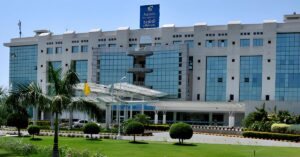Best Doctors in India for Stapedectomy
Best Hospitals in India for Stapedectomy
- City: Mumbai, India
Hospital Highlights:
- Fortis Hiranandani hospital was established in 2007.
- The hospital is an advanced tertiary care, multi-specialty hospital equipped with 149 beds.
- The hospital is equipped with a super ICU to provide emergency medical care to critically ill patients.
- The hospital is NABH accredited.
- The critical care facility in the hospital is augmented with the state-of-the-art facilities that facilitate speedier diagnosis and efficient monitoring.
- The hospital provides specialty medical services in cardiology, orthopedic science, pediatric science, neurology, diabetic care, urology, nephrology, ENT, obstetrics, gynecology, cosmetic surgery, bariatric surgery, neuro and spine care.
- City: Gurugram, India
Hospital Highlights:
- W Pratiksha Hospital, Gurugram, is one of the best hospitals in the NCR region. It is also a top hospital in India for IVF. Since its inception, the hospital has performed over 5500 successful IVFs. The hospital also specializes in gynecology.
- With over 20 years of experience in providing quality healthcare, the hospital is known as one of the most trusted and valued health providers in India.
- Equipped with world-class medical facilities and advanced technology, the hospital’s doctors and clinicians also have a track record of delivering excellent results. The hospital is also known for focusing on preventive well-being as much as on curative treatment.
- The hospital has earned the trust of its patients, by providing the best available treatments at affordable costs.
- City: Gurugram, India
Hospital Highlights:
- Paras hospital was established in 2006 and is the 250 bedded flagship hospital of Paras Healthcare.
- The is supported by a team of doctors of international and national repute.
- The hospital is NABH accredited and also the first hospital in the region to have a NABL accredited laboratory.
- The hospital provides specialty medical services in around 55 departments including Neurosciences, Joint Replacement, Mother & Child Care, Minimal Invasive Surgery, Gynecology and Obstetrics, Ophthalmology, Dermatology, Endocrinology, Rheumatology, Cosmetic and Plastic surgery.
- The hospital is equipped with state-of-the-art technologies.
- City: Kolkata, India
Hospital Highlights:
- Fortis Hospital, Anandapur, Kolkata is a world-class super-speciality equipped with the latest technologies in the medical world.
- The hospital is NABH accredited.
- This state-of-the-art facility specializes in cardiology and cardiac surgery, urology, nephrology, neurosciences, orthopaedics, digestive care, emergency care and critical care.
- The hospital, governed by integrated Building Management System (IBMS), has a pneumatic chute system, for quick vertical and horizontal transportation between floors, facilitating speedy transfer of patient specimens, documents, reports, and medicines to the concerned departments.
- The hospital also has a nephrology department with over 28 advanced dialysis units.
- City: Mumbai, India
Hospital Highlights:
- SL Raheja hospital is a 140-bed multi-specialty tertiary care hospital that is being managed by Fortis Healthcare Ltd.
- The hospital is a benchmark in healthcare and medical facilities in the neighborhood of Mahim & the western suburbs.
- L.Raheja Hospital, Mahim has one of the most effective ICU and Casualty care services.
- The hospital provides specialty medical services in Cardiology, Oncology, Neurology, Orthopedics, Mother & Child Care, and in Diabetes.
- City: Mumbai, India
Hospital Highlights:
- Wockhardt Hospitals were established in the year 1973, originally called First Hospitals and Heart Institute.
- Wockhardt Hospitals are super specialty health care networks in India, nurtured by Wockhardt Ltd, India’s 5th largest Pharmaceutical and Healthcare company.
- Wockhardt Hospitals is associated with Partners Harvard Medical International, an international arm of Harvard Medical School, USA.
- Wockhardt Heart Hospital performed India’s first endoscopic heart surgery.
- The hospital has a state-of-the-art infrastructure equipped with the latest technologies and modern equipment.
- It has special Centers of Excellence dedicated to the major specialties to provide hassle-free and high-quality clinical care.
- City: Gurugram, India
Hospital Highlights:
- The CK Birla Hospital in Gurugram is a NABH-accredited multi-specialty hospital.
- The hospital strives to increase the quality of healthcare by focusing on UK NHS nurse and midwife training requirements. Policies and practices derived from the National Institute for Health and Treatment Excellence (NICE) recommendations in the United Kingdom ensuring that a strong focus on safety, high-quality clinical care, and sanitation is maintained.
- The hospital’s cutting-edge technology and facilities allow for real-time communication and seamless collaboration among caregivers, ensuring accuracy and the best possible results. Those with foreign experience and accreditations make up part of the hospital’s team of clinicians.
- City: Ahmedabad
Hospital Highlights:
- As a member of the Apollo Hospitals Group, Apollo Hospitals International Limited, Ahmedabad is one of the most popular and sought-after medical facilities in Gujarat.
- Through its 6 Centres of Excellence and various affiliated branches, which cover all specialties and subspecialties, the hospital provides the most advanced clinical services.
- Since its inception in 2003, the hospital has been providing each patient with the most up-to-date medical equipment and state-of-the-art technology.
- With more than 150 successful organ transplants, including liver and renal transplants, the facility has been able to build a strong and extensive organ transplant program.
- In addition to performing 600 surgeries and caring for over 1800 patients on an IP basis, the hospital sees more than 18,000 patients on average in the outpatient department.
- With one of the biggest cardiology teams in the area, the hospital provides state-of-the-art regional care treatment in Cardiac Sciences.
- Additionally, the hospital offers a broad range of Neuro Interventional techniques to help stroke patients recover more quickly.
- City: Noida, India
Hospital Highlights:
- Jaypee Hospital is the flagship hospital of the Jaypee Group.
- This hospital has commissioned 525 beds in the first phase and has been planned and designed as a 1200 bedded multi-specialty facility.
- It holds the accreditation of the NABH and NABL.
- The hospital has state-of-the-art infrastructure equipped with the latest technologies and modern equipment like 64 Slice PET CT, Dual Head 6 Slice SPECT CT, Gamma Camera, and Da Vinci Robotic Surgery for comprehensive robotic surgical solutions.
- It has special Centers dedicated to the major specialties to provide hassle-free and high-quality clinical care.
- City: Mumbai, India
Hospital Highlights:
- Reliance Hospital is one of the best super-specialty care hospitals in Navi Mumbai.
- The main purpose of this hospital is to become a trustworthy place for the best health and hope for society. The hospital is well connected to the suburbs of Mumbai and Navi Mumbai.
- The hospital has various specialty departments, viz., Accident & Emergency, Anesthesiology, Dental Services, Dermatology, Diabetology, Dietetics Nutrition, Endocrinology, ENT, Gastroenterology, General Surgery, Gynaecology And Obstetrics, Hepato Pancreato Biliary Surgery, Infectious Disease, Internal Medicine, Interventional Radiology, Laboratory Medicine, Minimal Access Laparoscopic Surgery, Nephrology, Neurosciences, Opthalmology, Orthopaedics, Paediatrics, Pain Management Palliative Care, Physical Medicine Rehabilitation, Plastic And Reconstructive Surgery, Psychiatry, Pulmonary Medicine, Radiology, Rheumatology, Transplant, Urology Andrology, Vascular Surgery
Stapedectomy
Stapedectomy is a procedure used for the removal of the stapes bone in the ear. The stapes bone is the third of the three tiny bones in your middle ear as well as the one closest to the inner ear.
Though it is the smallest bone in the body, it has an important role in translating movement from your eardrum to the fluids in the inner ear, which causes sound waves to be changed into nerve impulses that can be translated in your brain.
Sound causes the stapes bone to vibrate. This vibration eventually passes into the fluid of the inner ear which enables hearing. When the stapes bone is unable to vibrate, it can lead to a decrease or loss of hearing.
Purpose
One of the most common reasons why people go for a stapedectomy is due to otosclerosis. Otosclerosis is a growth of bone around the stapes that can prevent its vibration, which ultimately leads to loss of hearing. Therefore, this leads to the requirement of surgery so that hearing can be improved. A stapedectomy involves removing your damaged stapes bone and replacing it with an artificial one. Sometimes surgery can also be done to correct the bone if it is fractured or abnormally shaped.
Patients suffering from otosclerosis and significant hearing loss are usually considered candidates for this procedure. Before the procedure, patients need to undergo an audiometric test, as well as a consultation with the ear surgeon to determine how appropriate a stapedectomy is going to be for him/her.
Preparation
Before your procedure, it might be important to give up certain medications for some time, as they can lead to complications during the procedure or recovery period. Your doctor will discuss with you which medications you will need to avoid. Also, make sure that you do not start taking any new medications, supplements or herbs without first consulting with your doctor.
Arrange for a ride home after the procedure. It is likely that you will need help at home during your recovery period so it is best if you can arrange for someone to help you in this period as well.
On the night before your procedure, it is likely that your doctor will recommend you to eat a light meal and not to eat or drink anything after midnight unless your doctor tells otherwise.
Procedure
First, your surgeon might use general or local anesthesia, depending on your procedure as well as your overall health.
If general anesthesia is used, you will be asleep during the entire procedure. If local anesthesia is used, the surgery area will be numbed. You might also receive a sedative to help you relax.
The surgery will involve your surgeon removing all or part of the original stapes bone and replacing them with an artificial device. This will allow sound waves to be sent once again to your inner ear for hearing.
Your surgeon will perform your procedure through your ear canal and uses an operating microscope. Then the eardrum is lifted for exposing the middle ear bones. Once the stapes are removed, your doctor will place the artificial device. Then the eardrum is put back into its position to heal. Packing material which is later absorbed by your body is used to hold it in place.
The procedure generally takes around 90 minutes and the majority of patients are able to go back home the same day.
After the procedure
You will be kept and monitored in a recovery area until you are ready to go back home. In some rare cases, an overnight stay might be required though in most cases, patients should be able to go home the same day.
While you are at the hospital, the staff will take some steps so that they can reduce your chance of infection such as keeping your incisions covered.
Results
Most patients are able to experience better hearing immediately after the surgery, but might sometimes report things that may not be normal. The feeling of fullness in the ear should go away once the packing around the eardrum has been absorbed and fluid drains away. Full improvement can take around three to four months.
Make sure that you follow the instructions provided by your doctor or the healthcare team.
Call your doctor if you experience any of the following:
- Signs of infection, including fever and chills
- Discharge having a foul odor
- Swelling, redness, increased pain, excessive bleeding or any green or yellow discharge from your ear
On average, 90 percent of patients usually have complete success from the surgery which can result in significantly better hearing. If inner ear functions are normal, it can result in the restoration of near-normal hearing.
Around seven percent of patients generally recover partial hearing after the procedure, while two percent of patients experience no change in the hearing level. There is also a chance that one percent of patients might experience worse hearing after the procedure.
Risks
Some of the few risks that are associated with this procedure include:
- Dizziness or vertigo
- Changes in taste
- Sensitivity to loud noise
- Tinnitus
- Injury to your facial nerve
- Infection












